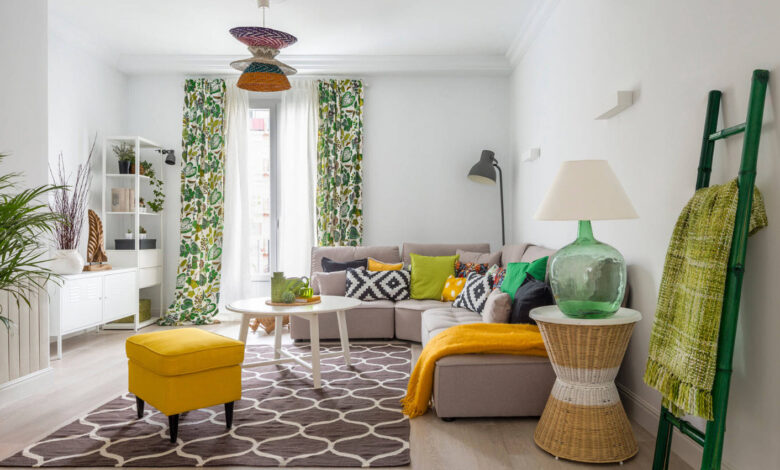Vibrant Interior Design: Bright Colors, Shapes, and Textures with Interior Designer London.

Interior design is an art that constantly evolves, reflecting cultural trends, technological advancements, and personal preferences. One of the most compelling trends in contemporary interior design is the use of bright colors, diverse shapes, and rich textures. These elements can transform a space, making it more lively, inviting, and stylish. This article explores various styles that incorporate these vibrant features, detailing how to use them effectively and organically integrate them into your living spaces.
The Appeal of Bright Colors, Shapes, and Textures
Bright colors, interesting shapes, and varied textures bring several benefits to interior design. They can make a space feel larger, more dynamic, and more personalized. Bright colors can lift the mood and create a sense of energy and positivity. Unusual shapes can add interest and focal points, while textures can add depth and tactile appeal, making a room feel more comfortable and engaging.
Modern Styles Incorporating Bright Colors and Textures
Several modern interior design styles effectively use bright colors, shapes, and textures. Let’s delve into some of the most popular ones:
1. Mid-Century Modern
Mid-century modern design, which emerged in the mid-20th century, is characterized by clean lines, functional forms, and an emphasis on the organic and geometric. This style often incorporates bold colors such as mustard yellow, teal, and burnt orange, alongside natural materials like wood and leather. To use this style:
- Colors: Choose a neutral base and add splashes of bright colors through furniture and decor.
- Shapes: Opt for furniture with clean lines and geometric shapes.
- Textures: Use a mix of smooth and textured materials, like wooden furniture with fabric upholstery.
2. Bohemian (Boho)
The Bohemian style is all about creativity, free-spiritedness, and eclecticism. It embraces a mix of colors, patterns, and textures to create a rich, layered look.
- Colors: Use a wide palette of bright and jewel tones.
- Shapes: Incorporate a variety of shapes, from traditional furniture to quirky, one-of-a-kind pieces.
- Textures: Layer different textures, such as woven rugs, embroidered cushions, and macramé wall hangings.
3. Contemporary
Contemporary design is always evolving, focusing on the latest trends and innovations. It often features a mix of bold colors and high-contrast elements.
- Colors: Use bold accent colors against a backdrop of neutral shades.
- Shapes: Include furniture with sleek, clean lines and innovative designs.
- Textures: Combine smooth, glossy surfaces with soft, plush textiles.
4. Industrial
Industrial style draws inspiration from old factories and industrial spaces. It combines raw and rough textures with a modern aesthetic.
- Colors: Stick to a neutral color palette with pops of brighter hues.
- Shapes: Use furniture with a robust, utilitarian look.
- Textures: Highlight raw textures like exposed brick, metal, and reclaimed wood.
5. Scandinavian
Scandinavian design is known for its simplicity, functionality, and connection to nature. It uses a lot of light colors and natural materials to create a serene, airy atmosphere.
- Colors: Focus on light, bright colors like white, pale blue, and soft pastels.
- Shapes: Choose furniture with simple, clean lines.
- Textures: Use natural textures like wood, wool, and linen.
How to Use Bright Colors, Shapes, and Textures
Effectively using bright colors, shapes, and textures requires balance and harmony. Here are some tips to help you incorporate these elements into your interior design:
Start with a Neutral Base
A neutral base allows bright colors and textures to stand out without overwhelming the space. Use shades like white, gray, or beige for walls and large pieces of furniture, then add color through accessories, artwork, and smaller pieces of furniture.
Create a Focal Point
Choose a focal point in the room, such as a brightly colored sofa, a bold piece of artwork, or a textured rug. This helps to draw the eye and create visual interest.
Balance Bold Colors with Neutrals
When using bright colors, balance them with neutral shades to avoid creating a space that feels too chaotic. For example, if you have a brightly colored wall, keep the furniture and accessories more subdued.
Mix and Match Textures
Layering different textures can add depth and richness to a space. Combine smooth and rough textures, like a sleek leather sofa with a chunky knit throw or a shiny metal lamp with a soft fabric shade.
Use Shapes to Create Interest
Incorporate a variety of shapes to add visual interest. Mix round and angular furniture, or combine straight lines with curves in your decor. This creates a dynamic, engaging space.
Be Mindful of Proportions
Ensure that the proportions of your furniture and decor items are balanced. Oversized furniture in a small room can feel overwhelming, while too many small pieces in a large space can feel cluttered.
Organically Fitting Styles into Your Space
Integrating bright colors, shapes, and textures into your space requires a thoughtful approach. Here are some strategies to ensure a harmonious design:
Understand Your Space
Consider the size, layout, and natural light of your room. Bright colors and bold shapes can make a small room feel larger, while a large space can handle more intense colors and varied textures.
Reflect Your Personality
Your home should reflect your personality and tastes. Choose colors, shapes, and textures that resonate with you and make you feel comfortable.
Plan Your Palette
Create a cohesive color palette before you start decorating. Choose a few main colors and a couple of accent colors to use throughout the space.
Experiment with Patterns
Don’t be afraid to mix patterns, but do so thoughtfully. Combine different patterns that share a common color or theme to create a harmonious look.
Use Natural Light
Natural light can enhance the impact of bright colors and textures. Ensure your space is well-lit, and use mirrors to reflect light and make the room feel more open.
Seek Professional Help
If you’re unsure how to start, consider consulting an interior designer. For example, an Interior Designer London could provide expert advice on using bright colors, shapes, and textures in your home.
Case Study: Transforming a Living Room
Let’s consider a practical example of transforming a living room using bright colors, shapes, and textures. An Interior Designer London was tasked with redesigning a small, dull living room into a vibrant, modern space.
Initial Assessment
The designer assessed the space, noting the natural light, existing furniture, and overall layout. The goal was to create a lively, welcoming room that felt larger and more dynamic.
Choosing a Color Palette
The designer chose a color palette of soft gray for the walls, with accents of teal, mustard yellow, and coral. These colors would add vibrancy without overwhelming the space.
Selecting Furniture
The furniture selection focused on clean lines and geometric shapes. A gray sectional sofa provided a neutral base, while a mustard yellow armchair and a teal coffee table added pops of color. A round, glass-topped coffee table created contrast with the angular lines of the sofa.
Adding Textures
To add depth, the designer incorporated a variety of textures. A plush area rug in a subtle pattern anchored the seating area, while velvet cushions on the sofa added a touch of luxury. A woven throw and a knitted pouf introduced additional textures, creating a cozy, layered look.
Incorporating Artwork and Decor
Bold artwork in complementary colors was hung on the walls, creating focal points and adding interest. Decorative accessories, such as ceramic vases and metal candleholders, provided additional texture and visual appeal.
Enhancing Natural Light
Mirrors were strategically placed to reflect natural light and make the room feel larger. Light, sheer curtains allowed maximum light to enter while adding a soft, airy feel to the room.
Final Touches
The designer added final touches, such as indoor plants for a touch of nature and books and personal items to make the space feel lived-in and personal.
Using bright colors, diverse shapes, and rich textures can transform any interior space into a vibrant, stylish haven. By understanding the principles of these elements and how to balance them, you can create a dynamic and engaging environment that reflects your personality and enhances your living experience.
Whether you’re drawn to the clean lines of mid-century modern, the eclectic mix of Bohemian, or the sleek aesthetics of contemporary design, there’s a style that can incorporate bright colors and textures in a way that suits your tastes. Remember, an Interior Designer London can offer invaluable guidance and expertise, helping you achieve the perfect balance in your home.
By thoughtfully integrating these elements, you can create a space that is not only visually stunning but also comfortable and inviting. Embrace the power of bright colors, varied shapes, and rich textures to elevate your interior design and make your home a true reflection of your style.



